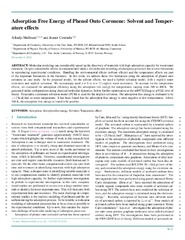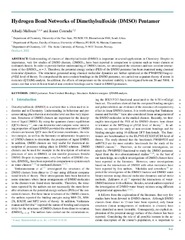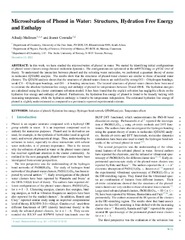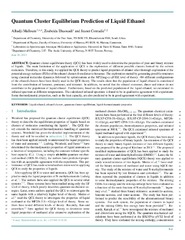Blar i forfatter "Malloum, Alhadji"
-
Adsorption free energy of phenol onto coronene: Solvent and temperature effects
Malloum, Alhadji; Conradie, Jeanet (Journal article; Tidsskriftartikkel; Peer reviewed, 2022-11-11)Molecular modeling can considerably speed up the discovery of materials with high adsorption capacity for wastewater treatment. Despite considerable efforts in computational studies, the molecular modeling of adsorption processes has several limitations in reproducing experimental conditions. Handling the environmental effects (solvent effects) and the temperature effects are part of the important ... -
Adsorption of some cationic dyes onto two models of graphene oxide
Mounra, Emma; Malloum, Alhadji; Fifen, Jean Jules; Conradie, Jeanet (Journal article; Tidsskriftartikkel; Peer reviewed, 2023-11-18)The search for highly efficient adsorbent materials remains a significant requirement in the field of adsorption for wastewater treatment. Computational study can highly contribute to the identification of efficient material. In this work, we propose a computational approach to study the adsorption of four cationic basic dyes, basic blue 26 (BB26), basic green 1 (BG1), basic yellow 2 (BY2), and basic ... -
Data to Understand the Nature of Non-Covalent Interactions in the Thiophene Clusters
Malloum, Alhadji; Conradie, Jeanet (Journal article; Tidsskriftartikkel; Peer reviewed, 2022-01-10)We have reported herein the data to understand the nature and number of non-covalent interactions that stabilize the structures of the thiophene clusters. In addition, we have also provided the optimized Cartesian coordinates of all the structures of the investigated thiophene clusters. Initially, the geometries have been generated using the ABCluster code which performs a global optimization to ... -
DFT benchmarking for adsorption energy in wastewater treatment
Malloum, Alhadji; Conradie, Jeanet (Journal article; Tidsskriftartikkel; Peer reviewed, 2023-07-31)Despite its potential importance, the computational chemistry of adsorption processes for wastewater treatment has received negligible attention. Exploring the literature shows several limitations in applying quantum chemistry to study adsorption processes in wastewater treatment. The choice of suitable functionals of density functional theory (DFT) is one of the critical limits of the current ... -
Dimethylsulfoxide (DMSO) Clusters Dataset: DFT Relative Energies, Non-Covalent Interactions, and Cartesian Coordinates
Malloum, Alhadji; Conradie, Jeanet (Journal article; Tidsskriftartikkel; Peer reviewed, 2022-03-07)Theoretical understanding of dimethylsulfoxide (DMSO) liquid depends on the understanding of the DMSO clusters. In this work, we provide the structures and the energetics of the DMSO clusters. The structures have been generated using ABCluster and further optimized at the MP2/aug-ccpVDZ level of theory. The final structures have been optimized at two different levels of theory: PW6B95D3/aug-ccpVDZ ... -
Hydrogen bond networks of dimethylsulfoxide (DMSO) pentamer
Malloum, Alhadji; Conradie, Jeanet (Journal article; Tidsskriftartikkel; Peer reviewed, 2022-10-17)Understanding of clusters of dimethylsulfoxide (DMSO) is important in several applications in Chemistry. Despite its importance, very few studies of DMSO clusters, (DMSO)<i><sub>n</i></sub> , have been reported in comparison to systems such as water clusters or methanol clusters. In order to provide further understanding of DMSO clusters, we investigated the structures and non-covalent interactions ... -
Microsolvation of phenol in water: structures, hydration free energy and enthalpy
Malloum, Alhadji; Conradie, Jeanet (Journal article; Tidsskriftartikkel; Peer reviewed, 2023-01-05)In this work, we have studied the microsolvation of phenol in water. We started by identifying initial configurations of phenol-water clusters using classical molecular dynamics. The configurations are optimised at the ωB97XD/aug-cc-pVDZ level of theory. To understand the interaction between phenol and the solvating water molecules, we performed a quantum theory of atoms in molecules (QTAIM) analysis. ... -
QTAIM analysis dataset for non-covalent interactions in curan clusters
Malloum, Alhadji; Conradie, Jeanet (Journal article; Tidsskriftartikkel; Peer reviewed, 2021-12-21)Furan clusters are very important to understand the dynam- ics and properties of the furan solvent. They can be used combined with quantum cluster equilibrium theory to theo- retically determine the thermodynamics properties of the fu- ran solvent. To understand the structures of the furan clus- ters, one needs to understand the non-covalent interactions that hold the furan molecules together. ... -
Quantum cluster equilibrium prediction of liquid ethanol
Malloum, Alhadji; Dhaouadi, Zoubeida; Conradie, Jeanet (Journal article; Tidsskriftartikkel; Peer reviewed, 2023-07-17)Quantum cluster equilibrium theory (QCE) has been widely used to determine the properties of pure and binary mixture of liquids. The main limitation of the application of QCE is the exploration of different possible clusters formed by the solvent molecules. Therefore, in this study, we applied the QCE theory to predict liquid properties of ethanol after thorough exploration of the potential energy ...


 English
English norsk
norsk







